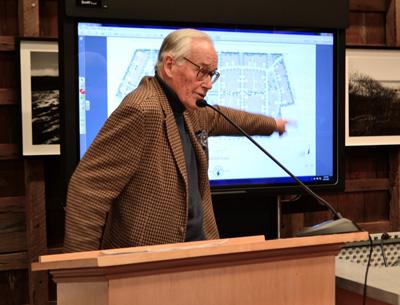Planning Board Weighs In on Condo Complex

The developer proposing to build 89 condominium units targeting affluent baby boomers on 24 acres of open farmland in Amagansett told the East Hampton Town Planning Board on May 15 that he was there to listen.
He got an earful.
Starting with JoAnne Pahwul’s 20-page memo to the board summarizing the proposal, which is in a very preliminary state, it was clear from comments that no one in Town Hall that night favored it as currently constituted, save for Francis P. Jenkins III, the head of a company called Putnam Bridge, and his team of planners and architects.
Mr. Jenkins said at the end of the meeting that he welcomed the feedback, negative though it might be, and would reassess and retool the proposal. The development requires a major zoning change by the East Hampton Town Board before it can even begin to become a reality.
Ms. Pahwul, the town’s assistant planning director, told the board that “the proposed project does not meet the year-round residents’ needs. It protects neither farmland” nor open vistas, she added.
Robert Schaeffer expressed surprise that such a proposal was even possible, asking why it was not before the board as a subdivision. He asked a fellow board member, Pat Schutte, if he had ever seen anything similar, and Mr. Schutte replied that he hadn’t.
Mr. Schutte and Mr. Schaeffer are the longest-serving members on the board.
“It’s co-ops,” Diana Weir said, explaining why a subdivision of the land was not needed. “They are not going to own their own piece of dirt.”
“I think this has a long way to go. The pricing is an issue. The density is going to be an issue,” she concluded.
Mr. Schutte expressed concern about the self-contained septic treatment system. “One issue is ground flow from the waste. We have seen a lot of new sanitary systems come and go. That is a very big hurdle for you to overcome,” he told Mr. Jenkins.
Jacquelin Robertson of Cooper, Robertson, and Partners, an architectural and urban design firm, touted the plan for Mr. Jenkins, who also spoke to the board at length. “Very few places are places you go to and say, ‘I want to come back,’ ” Mr. Robertson said.
While complimenting Ms. Pahwul’s memo, he told the board that he, too, was a planner, having worked in that position for an extended time for the City of New York. “We’re trying to produce a place that is not scary,” he said, “it is as green a project as the town has ever seen.”
The plans call for 100-percent on-site sewage treatment, as well as solar panels to power the facility, Mr. Robertson said. “Global warming has caught up with us,” said the architect.
He talked about revegetation after the massive project is built. “There are about five things that grow here,” he told the board, “that won’t grow anywhere else,” mentioning, for one, Korean dogwood. “This place is a place where the natural world of the East End is in full force.” He also named privet.
When asked why the plan features a windmill, Mr. Robertson told the board it was an “iconic” image for the East End. He also called the idea of preserving the town’s agricultural land “a dream.”
“We can’t ignore the values our town has,” Ian Calder-Piedmonte, a board member, said. “You can say that agriculture is a dream. At this point, we need more information.”
Speaking toward the end of the discussion, the board’s chairman, Reed Jones, remarked that “I tend to be pro-business, pro-development . . . we can’t overlook that the applicant has the right to some development.” But, he said, “You’re trying to do an awful lot on those 23 acres. I have been in a lot of places in this world, and we have a very special place . . . I don’t want to fumble it.”
The planning board held the preliminary review in case the town asks for its comments. Ms. Pahwul wrote in her memo that “the project is not permitted under current zoning and is dependent on the town board’s approval of a senior citizen housing overlay district. . . . If the town board decides to proceed to a public hearing on the proposal, formal comments from the planning board will be required.”
After the meeting was over, Mr. Jenkins huddled with his team outside the hall. He said he planned to incorporate the board’s comments into the proposal.
